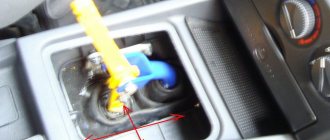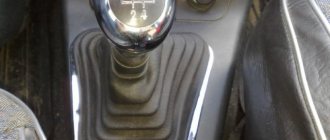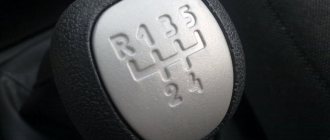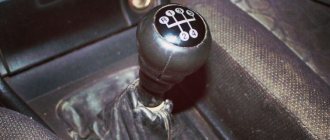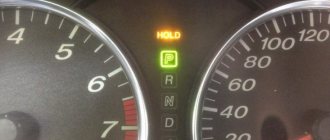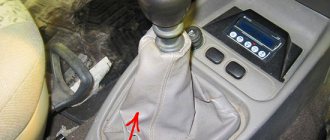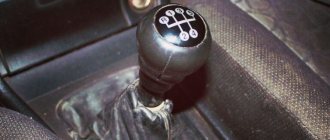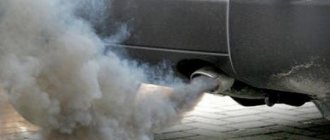When buying a car, many drivers give preference to manual transmission, considering it more reliable. A manual gearbox has several advantages, the main one of which is its unpretentiousness. If we compare a manual transmission with an automatic transmission or a variator, then in the event of damage or failure of any elements of the manual transmission, repairs will cost the driver relatively inexpensively.
With proper operation and timely maintenance, a manual transmission will not require special attention. However, in practice, problems may arise over time in the operation of a manual transmission, as in other components of the car. One of the common problems with manual transmissions is the crunching noise that occurs when shifting the gear lever. In this case, the driver needs to determine the cause and fix the problem.
Read in this article
The transmission is noisy in neutral and howls at speed.
Main causes of malfunction:
- insufficient oil level in the manual transmission. If there is a lack of transmission fluid, the lubrication of the rubbing pairs deteriorates. Thermal expansion and dry friction leads to noise and howling when moving. If the car has covered hundreds of thousands of kilometers, you should not be alarmed by slight noise when operating in neutral. We recommend limiting yourself to only changing the oil in the manual transmission.
If extraneous noise from the gearbox occurs when the clutch is depressed, the release bearing is faulty.
- gear wear. The reason is the development of gear teeth at the contact points. In this case, only replacing worn parts will help eliminate noise and howling;
- wear of the bearings of the driven, drive or intermediate shaft. As a result of oil starvation, heavy loads, increased torque after boosting the engine, or natural wear, abrasions, scuffing and uneven performance appear on the rolling elements and bearing races;
- production of differential parts for front-wheel drive cars. In such cases, vibrations are common when accelerating.
Some VAZ models are worthy of a special note, in which the manual transmission begins to make noise, howl and vibrate at relatively short distances. Many people attribute the malfunction to a design defect and the quality of manufacturing of transmission parts, which makes the idea of any repair very doubtful.
Gearbox crunches: signs
While driving or braking the car when shifting the gearbox, the driver may hear extraneous sounds, such as crunching, grinding or crackling.
Moreover, most often, extraneous sounds when turning on the gear lever may appear only in one of the gears, for example, only when switching to first or only when switching to second, etc. Also, when returning the gear lever to the neutral position, an unpleasant cracking or grinding.
- Crunching noise when shifting into second gear. Shifting into first gear is smooth and quiet, but there is a rattling sound when shifting from first to second gear. This happens when the car accelerates, when the engine speed increases. Moreover, all other gears shift without a crunch at any speed.
- Switching from third to second gear may also be accompanied by a crunching sound, and shifting gears can be difficult. One way or another, the problem may be a failed transmission synchronizer, since the element is subject to heavy loads.
It is important to understand that if shifting the gearbox lever to higher or lower speed is accompanied by an incomprehensible crackling or grinding noise, the cause should be determined and eliminated as soon as possible.
Gears engage poorly and with a crunch
Difficulty shifting gears and a metallic grinding noise at the moment of shifting are clear signs of a malfunction of the manual transmission synchronizers. But before removing the gearbox for repairs, check the gear selector and clutch. Play in the gearshift lever, cable jamming, and incorrect adjustment of the gear selection mechanism lead to unclear and often poor gear shifting. And incomplete disengagement of the clutch after pressing the pedal (the clutch is moving) will cause crunching and grinding sounds. Driving with such a malfunction will quickly damage the synchronizers.
If your car only shifts into second or, for example, third gear with a crunch, then the problem is most likely with the synchronizers. These elements are intended to equalize the rotation speed of the output shaft and the gear engaged in the transmission. Wear of the conical friction part leads to slipping of the blocking ring and rigid engagement of the clutch with the gear teeth. When disassembling and troubleshooting, you should also pay attention to gears, gear clutches and their forks.
Knocks out the speed
The synchronizer blocking ring and gears have specially shaped teeth with which the clutch engages when changing speeds. If the coupling splines, teeth on the ring and gear are ground down, then when the load is applied and the gas pedal is released, the transmission spontaneously switches off. In this case, it will not be possible to limit yourself to replacing synchronizers; you should definitely change the gear of the damaged transmission and the gear shift clutch.
The speed will be knocked out even if it is not turned on completely. Possible causes of manual transmission malfunction:
- wear of the rod, gear shift fork;
- cable jamming;
- incorrect installation, wear of the intermediate shaft bearing;
- wear of the manual transmission cushion, which causes the box to shift under load;
- loose gearbox housing bolts.
Oil leak from manual transmission
Possible causes of oil leakage:
- wear of the drive shaft oil seal;
- torn boot of the inner CV joint;
- loose pressure of the manual transmission pan, loose inspection hole bolt.
Rumble and howl
A humming or crunching noise that appears relatively suddenly and becomes very loud over a short period of time may indicate damage to the gear teeth or wheel bearings.
The most likely source of this damage is a lack of lubrication. If the oil film on the gear teeth becomes too thin, they will grind against each other, which will subsequently destroy the smooth surface of each tooth and cause them to mesh roughly. Even if the oil is changed or topped up to facilitate lubrication, damaged gears will never recover.
Other common sources of gear tooth damage include corrosion and wear. Water in transmission oil can attack the steel surface of each gear, eventually leading to pitting and abnormal wear.
Changing the oil is often a proven method of preventing corrosion. Gear wear is inevitable and irreversible. However, ensuring there is sufficient clean and suitable lubricating oil in the gearbox can significantly reduce the amount of wear on its surface.
Rumbling and growling
Low rumbling noises and crunching noises when the engine is running are usually a sign of a bad bearing (also known as a ball or roller bearing). It is extremely sensitive to small pieces of metal or dirt in the lubricating film between the supporting elements, and causes the rollers to move along the raceway surface. The more foreign substances in the oil, the faster the bearing wears out.
The crunching sound of a damaged transmission bearing will become increasingly noisy as it wears until the bearing cracks or falls apart, with catastrophic consequences.
One of the main functions of bearings in a gearbox is to maintain the correct clearance between pairs of gears. If the bearings begin to wear and weaken, the gears may begin to mesh improperly and become damaged due to bent contact. If the bearing falls apart, the results are equally bad. Small pieces of steel from a broken bearing will travel through the transmission and can become lodged between the gear teeth. Ultimately, this can break the teeth of the gears and damage them. If one of the bearings seizes, it will likely damage the transmission as well.
Buzzing and hissing
If the gear shifter makes a hissing, buzzing noise in addition to a squealing noise while the vehicle is moving, especially when accelerating or decelerating, the most common cause is a loose bolt or worn shims in the shift lever. Other causes of these high-frequency noises include bent shift forks, shift rods or locks, or even excessive movement of the synchronizer bushings.
In all these cases, the noise is caused by the shift fork contacting the grooves. This causes a hissing noise and crunching noise that travels through the gearshift lever.
Knock
A knocking or rattling sensation in the gearshift lever heard underneath the vehicle usually indicates a broken or loose engine mount. Typically the noise is loudest when the clutch is released while accelerating from a stop. Alternatively, if the rear transmission is faulty in a rear wheel drive vehicle, the noise will occur when the clutch is released in reverse as the transmission shaft lifts up and slams down. Broken fasteners can also cause noise during gentle acceleration and deceleration.
Another common sign of engine damage is clutch knocking. Contrary to popular belief, clutch whine is almost never caused by the clutch disc or flywheel; it is usually the result of overly flexible engine mounts, which may be due to design or wear.
The most common transmission complaint is a clunking or grinding noise when shifting into gear, which usually feels as much as it sounds.
The noise itself is caused by the ends of the inner splines of the synchronizer bushing coming into contact with the splines of the outer teeth as the gear and bushing rotate at different speeds. This occurs as a direct result of a failure in the synchronization process. Ineffective synchronizer operation can be caused by either a problem in the transmission or a separate clutch problem.
Although cone-type synchronizers are simple and reliable, they rely on friction and therefore the locking rings will break down over time. They are also easily damaged when shifting gears without a clutch, as well as when using incompatible lubricants.
The synchronizer rings wear heavily when the clutch does not fully disengage because they are forced to act against higher speed variations for which they are not designed.
The crunching will also lead to grinding of the sharp end of the synchronizer bushing splines and gear teeth, and wear will lead to deterioration in the performance of the synchronizer and its hard shifting.
Jerky gear changes can be the result of any number of internal and external problems. End clearance or preload problems with individual gears on the input shaft are the two most common, although clutch problems, worn bearings and synchronizers can also cause gears to fall out in certain situations.
TOP 6 common mistakes with manual transmission
Shifting gears without clutch
It sounds very strange, given the type of gearbox, but beginners and drivers who have been driving an automatic for a long time often forget to depress the clutch when shifting.
The result is a strong crunch, and a quick realization of the mistake made. At these moments, the box experiences unforeseen loads due to the fact that at the moment of switching the box is not disconnected from the engine, and therefore is under load. Sometimes such pranks end in licking or, even worse, breaking off fragments of gear teeth. As a result, the mechanism “grinds” itself and the manual transmission is simply inevitable.
Clutch depressed
Many car enthusiasts systematically hold the clutch pedal depressed for a long time. For example, when they are standing at traffic lights or just stopped.
This, at first glance, harmless action leads to increased wear of the clutch disc, but what “suffers” the most is the release bearing, which is tirelessly forced to rotate under load. As a result, it quickly becomes unusable (it buzzes), as a result of which it will require immediate replacement, because there is a risk that it will “scatter” right on the move. By the way, to replace it you will have to remove the box, which is not a cheap pleasure.
Engaging reverse gear without coming to a complete stop
A classic of the genre, the driver tries to quickly turn around in the yard, in a hurry, first and then reverse gears. We hear an unpleasant grinding noise when we obviously try to engage the rear.
The reason is simple: the pilot is trying to engage reverse without making a full stop. This has an extremely negative effect on the teeth of the reverse gears, which slowly become unusable due to licking off on one side. If such an error becomes permanent, the reverse gear will engage worse and worse from time to time, until it completely fails.
Downshifting by two or more
Due to the fact that in a manual transmission the function of selecting gears is assigned to the driver, there is a high probability of engaging an inappropriate gear. In cases with downshifts, this is especially dangerous. After all, if the wheel speed turns out to be higher than the maximum possible in the gear selected by the driver (cutoff), when the clutch is released, extreme engine braking will occur. As a result, not only can the gearbox and clutch fail, but also the timing belt in the engine can jump over a couple of teeth (the chain is no exception, but less often), or even break completely (usually an expensive repair).
In addition, with such sharp engine braking, the drive wheels will slow down momentarily, incomparably with the speed of the car, which can cause the car to fall off the trajectory when turning, especially in winter.
If you drive a manual transmission, you should know which gear is which “maximum speed” and avoid “wrong” downshifts.
Hand on the lever
Many drivers, when moving, keep their hand on the gearshift lever, as if on an armrest.
On the one hand, it seems to be convenient, on the other hand, it loosens the mechanism and “kills” the forks that directly move the clutches in the gearbox. Those who want to save the box must understand that while driving the car oscillates chaotically and the driver does not consciously hold on to everything his hands are on. As a result, the load on the lever turns out to be not so small, and the box loses its original “tightness”
Breakdowns causing crunching
Does the gearbox crunch when changing gear? There may be only five reasons, but whatever it is, “surgical” intervention in the transmission is required. A slight scare will not do here, so fix it yourself or, if you have no experience, take it to a car service center.
- Synchronizer:
the reason is precisely its wear due to the lack of an adequate level of lubrication or its old age. In such cases, any lubricant will turn from a useful substance into a harmful environment that destroys everything. It is advisable to eliminate the cause at a certified service station, since the slightest mistake can lead to failure of the entire unit; - “Basket”:
structurally, it consists of “petals” as people call it, so after a certain mileage, which is different for everyone, they begin to loosen and fall out. As a result, the driver cannot “push up” the speed. There is only one piece of advice: completely replace the basket, and at the same time carry out a visual diagnosis of the synchronizers. Replace if necessary; - Clutch cable:
typical for most domestically produced cars. In such cases, you will not be able to turn on anything at all. You can get to the service station only by turning on the gear, and then start the car with the battery while you are moving and then continue only at this speed. The repair will take you no more than 10 minutes, just replace the cable with a new one; - Box shaft:
friction from rotation can cause a critical increase in temperature and, as a result, burst one or another unit. There is only one way out: disassembling and replacing the contents. The main thing is that the shaft does not jam while moving, as the consequences can be much more serious; - Factory defects:
anything can happen. It is necessary to completely replace the unit that has failed.
As practice shows, most breakdowns are due to untimely replacement of the lubricant. For some reason, some drivers have the opinion that automatic ones need to be changed, but not manual ones. So it turns out that the lubricant loses its properties, which leads to breakdowns.
To prevent this from happening, every driver should look at the operating instructions and act according to the recommendations. must take place strictly within certain deadlines.
Most manufacturers recommend replacement at 45-50 thousand km. mileage
This number is the golden mean. Tightening is not recommended. Of course, depending on operating conditions, the figure can be changed (but only downward). If climatic conditions are characterized by critical temperatures towards minus or plus.
I would like to note that if the car is front-wheel drive, then a low oil level or worn-out oil is even worse for it than for a rear-wheel drive one. The whole reason is that the latter works autonomously
, but the front drive is in tandem with the front axle, which also needs to be rotated and lubricated. Therefore, car owners need to pay increased attention to this.
The main thing to remember is that timely and comprehensive replacement of spare parts and lubricants can protect your car from sudden breakdowns. This concludes the topic of what to do if the gearbox crunches when changing gear. We recommend that you familiarize yourself with our recommendations for drivers, regardless of experience and length of service. Apply our tips in everyday life when repairing your car.
When buying a car, many drivers give preference, considering it more reliable. A manual gearbox has several advantages, the main one of which is its unpretentiousness. If we compare mechanics with or, then in the event of damage or failure of any manual transmission elements, repairs will cost the driver relatively inexpensively.
With proper operation and timely maintenance, a manual transmission will not require special attention. However, in practice, problems may arise over time in the operation of a manual transmission, as in other components of the car. One of the common problems with manual transmissions is the crunching noise that occurs when shifting the gear lever. In this case, the driver needs to determine the cause and fix the problem.
Unsuitable oil
The transmission can be damaged if the wrong oil is used.
“The requirements for a modern gearbox oil are: good fluidity over the operating temperature range, reliable wear protection, excellent synchronization, high oxidation and shear stability, low tendency to foam, good seal compatibility, high efficiency,” says Vyacheslav Mikhailovich.
Different types of gearboxes require special gear oils recommended by the manufacturer. If the oil is selected incorrectly, slippage and vibration begin, fuel consumption increases, wear increases, and the oil can burn.
Worn bearings
If a grinding noise appears in the gearbox when you shift into gear, but the sound disappears when you shift to neutral, this may indicate wear on the bearings. If these bearings are not replaced in time, the box may jam, which will lead to expensive repairs.
“It is recommended to check the transmission in accordance with the requirements of the car manufacturer. It needs systematic visual inspection. Care must be taken to ensure that oil does not leak. In addition, dirt should not get there, otherwise the gears will shift worse,” advises mechanical engineer Andrey Semenov .
We determine which CV joint crunches, the inner or outer one
Several methods are used to diagnose CV joints. The simplest of them is a visual inspection of the anthers and checking the shafts.
The main cause of problems associated with the appearance of crunching is the ingress of dirt into the nodes, which can only occur due to damage to the boot.
If the rubber element is torn, then upon inspection there will be traces of leaking lubricant on it, from which you can understand which of the units got sand and dust.
Also, during inspection, you should try to move the drive shaft in the transverse and longitudinal directions by hand. CV joints are highly precision-manufactured units, and if it feels like they have play, it’s time to take action.
If, during a visual inspection, no leaks in the boot are detected, but symptoms of a joint malfunction appear, several simple methods can be used to identify which of the CV joints is problematic.
Diagnostics of external hinges
External hinges are tested by placing a strong load on them. To do this, simply turn the wheels all the way to the right or left and try to start moving at higher speeds. Afterwards, we carry out the same procedure again, but this time when turning the wheels in the other direction.
When checking CV joints using this method, starting to move with the wheels turning to the left will create a significant load on the right unit, and if it has play, it will begin to crunch.
By turning the wheels to the right, the left hinge is checked. But we note that a crunching noise can also be produced by the outer CV joint on the side where the turn is being made.
Therefore, when checking, it would not be superfluous to have an assistant present, who, being near the car, will establish by ear which side the sound is coming from.
Checking internal components
To determine which inner CV joint is crunching, a different method is used. To carry it out, you need a flat section of the road, but with a bump (hole).
The essence of the test comes down to driving through a hole at a moderate speed with one of the front wheels. Then everything is repeated, but with the second wheel entering the hole.
When a wheel hits a bump, a shock load occurs on the inner joint, and if there is play in it, they will manifest themselves in the form of knocks or soft crunches.
Universal method
The only drawback of the method of driving into a hole at speed is the fact that there is not always a suitable section of road with a bump. Therefore, another method can be used for diagnostics, and it is universal and allows you to check both internal and external CV joints.
The algorithm of actions is as follows:
- Use a jack to jack up one of the drive wheels;
- We place a stop under the car and apply the handbrake;
- We start the engine, engage first gear and gradually release the clutch pedal (we simulate the beginning of movement. At the same time, thanks to the differential, the suspended wheel will begin to rotate, and the one standing on the ground will remain motionless);
- Having gained engine speed, we begin to slow down the rotating wheel with the brakes (we do not touch the clutch pedal. Thus, with the brake mechanisms we create a load on the internal unit, and if it is problematic, it will immediately manifest itself with knocks and crunches);
- After checking the internal hinge, we determine the condition of the external one. To do this, just release the brake pedal, pick up speed, turn the wheels all the way to one side and use the brakes again. A large drive angle and brake force will create the necessary load, which will cause the external assembly to crunch if it is not working properly.
After checking on one side, we repeat similar work with the drive of the second wheel.
Incorrect operation of the transmission, as the cause of a crunching sound when shifting gears
It is fair to say that often a crunching sound when shifting gears may indicate that the manual transmission is not being used properly. Therefore, it would not be amiss to provide some recommendations that will extend the service life of the manual transmission.
1. Timely replacement of transmission fluid in the box
. Few people know, but in a manual transmission, just like in an automatic transmission, the oil should be changed periodically. A manual transmission does not require replacement as often as an automatic transmission, but still, after 70,000 kilometers, you should stop by a service station. If you ignore this recommendation, metal shavings and dirt will begin to accumulate in the oil, resulting in insufficient lubrication and crunching.
2. An insufficient amount of oil in the transmission can also cause a crunching sound when shifting gears. The solution is to add oil or, better yet, replace it.
As you can see, it’s quite easy to avoid crunching noise when changing gears!
When buying a car, many drivers give preference, considering it more reliable. A manual gearbox has several advantages, the main one of which is its unpretentiousness. If we compare mechanics with or, then in the event of damage or failure of any manual transmission elements, repairs will cost the driver relatively inexpensively.
With proper operation and timely maintenance, a manual transmission will not require special attention. However, in practice, problems may arise over time in the operation of a manual transmission, as in other components of the car. One of the common problems with manual transmissions is the crunching noise that occurs when shifting the gear lever. In this case, the driver needs to determine the cause and fix the problem.
How to recognize the presence of a malfunction?
To check the serviceability of a particular vehicle unit, the driver must turn off the radio before starting the trip. With the radio turned off, you can easily determine whether there are any extraneous noises and knocks when the mechanisms are operating. The following factors may indicate problems with the gearbox:
- A characteristic crunching sound when engaging a gear (and it can only appear in one of the gears);
- Crackling noise when returning the lever to neutral.
If at least one of the above symptoms appears, the driver needs to identify and eliminate the malfunction as quickly as possible. Otherwise, if you ignore this problem, more serious problems may arise.
Crunching noise when shifting gears: causes and methods of eliminating them
The causes of a crunching, crackling or grinding noise when the gearshift lever is engaged may be different. It all depends on the specific case.
In the event of a minor breakdown, without interfering with the box mechanism itself, the problem can be eliminated by replacing the damaged part. In another case, more serious, the problem is solved by overhauling the manual transmission itself.
The main breakdowns that cause crunching or crackling when changing gears:
- Failure of synchronizers. Synchronizers are responsible for smooth gear shifting. Over time, they wear out and cease to perform their functions. This leads to a crunching or crackling sound when changing gears. The problem is solved by replacing damaged synchronizers with new ones.
What's the result?
The appearance of a crunching sound in a manual transmission may be the first signal of a serious breakdown of this unit. Therefore, if symptoms such as crunching, grinding or crackling appear when switching the gearbox lever from high to low speed or vice versa, it is necessary to conduct a full diagnosis and identify the cause of the malfunction.
When comparing different types of transmissions, “mechanical” usually turns out to be the most problem-free and resource-efficient, but nothing lasts forever - with long-term use, problems can begin with a manual transmission. They often start with a crunching sound when changing gears. This does not immobilize the car - putting up with the unpleasant sensations, you can continue driving, but extraneous sounds should alert the driver - this is the first symptom of an impending gearbox failure. If the box still “crunches,” then what should you do?
How to avoid crunching noises in the gearbox
Incorrect operation and untimely maintenance of the manual transmission leads to problems in the operation of this unit. What you need to pay attention to first:
- Timely change of oil in the box. The quality and quantity of oil ensures optimal lubrication of shafts, gears and other mechanisms of the manual transmission. Vehicle manufacturers recommend changing the gearbox oil every 60 thousand kilometers of the vehicle.
- An insufficient amount of oil in a manual transmission can also lead to problems in the operation of this unit, namely, causing a crunching or crackling sound when shifting gears. In this case, the oil is either topped up or changed partially or completely.
How to change gearbox oil
The work of changing the oil in the box is carried out as follows:
- Place the car on an overpass or over a pit, warm it up slightly so that the liquid is not viscous. Locate the oil drain plug on the bottom of the box.
- The unit has a rubber cap that needs to be cleaned along with the breather. After cleaning these parts from dirt, return them to their place.
- As soon as the preparatory work is completed, place the container, twist the plug with a wrench, and begin draining the transmission oil.
- The waste liquid will drain completely within half an hour.
- Screw on the plug, tighten it well, but do not strip the thread.
- Under the hood, find the transmission dipstick and remove it. In place of the probe, stretch a hose, at the other end of which a regular watering can or funnel is installed. Pour transmission oil into the box through the hose. On older units, the fill plug is located next to the drain plug.
After the work is completed, check the lubricant level with a dipstick and take a control measurement after 2-3 days. If necessary, add oil; if it becomes critically low, inspect the box for leaks.
How to get rid of a crunching sound when engaging reverse gear
Now we invite you to familiarize yourself with the solution to the problem (crunching noise when engaging reverse gear) that service workers shared with us, as well as Prior owners who encountered this problem in their car:
Sources
- https://forum.skoda-club.ru/viewtopic.php?start=15&t=21818
- https://teron.online/index.php?showtopic=391441
- https://poperechka.ru/skrezhet-v-korobke-peredach-pri-dvizhenii/
- https://DriverTip.ru/repair/chto-delat-esli-hrustit-korobka-peredach.html
- https://avto-kontinent.ru/drugoe/hrustit-korobka.html
- https://chel.aif.ru/auto/shum_i_vibracii_priznaki_neispravnosti_korobki_peredach
- https://akppwiki.ru/pochemu-xrustit-zadnyaya-peredacha-na-lade-priora.html
